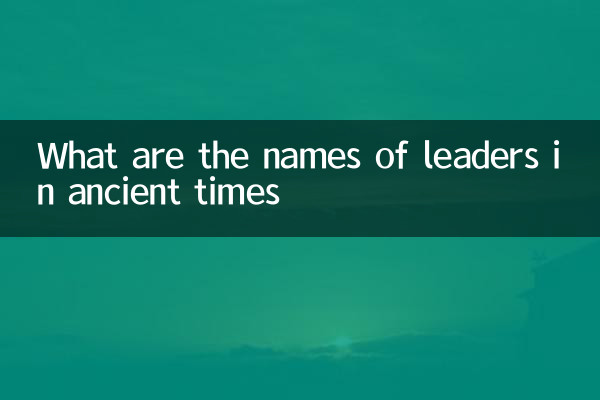What are the names of leaders in ancient times
In ancient society, the name of leadership varies depending on dynasty, position and cultural background. From emperors to local officials, each title carries specific historical and cultural connotations. The following is a structured compilation of the content related to ancient leaders’ names that have been hotly discussed across the Internet in the past 10 days.
1. The title of the supreme ruler in ancient times

The supreme ruler of ancient China was often called "emperor", but there were other titles in different dynasties and periods. Here are some common types:
| dynasty | call | Remark |
|---|---|---|
| Xia Shang Zhou | king | The supreme ruler of the Xia, Shang and Zhou dynasties was called "king" |
| Qin Dynasty | emperor | Qin Shihuang created the title of "Emperor" |
| Han Dynasty | His Majesty | The honor of the emperor by the minister |
| Tang Dynasty | saint | Emperors of the Tang Dynasty were often respected as "saints" |
| Ming Dynasty | Long live | The title of emperor by subjects of the Ming Dynasty |
2. The title of ancient officials
The names of officials in ancient times vary according to positions and levels. Here are several common official names:
| Position | call | Remark |
|---|---|---|
| Prime Minister | Prime Minister | The Supreme Chief Executive of the Qin and Han Dynasties |
| Shangshu | grown ups | The honorific title of the six ministers |
| County magistrate | Parents | Local people’s titles to county magistrates |
| General | marshal | The honorary title of senior military general |
| Prefect | House Lord | Respectful title of a government official |
3. The title of ancient royal family members
The names of members of the ancient royal family were also very complicated, and the following are the common ones:
| identity | call | Remark |
|---|---|---|
| Prince | Your Highness | The title of the heir to the throne |
| Queen | Lady | The honorific title of the queen in the harem |
| Princess | Thousands of gold | Respect for the princess |
| Prince | Prince | Respect for male members of the royal family |
| Queen Mother | Old Buddha | The Qing Dynasty's honor to the empress dowager |
4. The title of ancient local leaders
The names of local leaders in ancient times vary by region and position. Here are some common types:
| Position | call | Remark |
|---|---|---|
| Governor | Envoy | The title of the local chief executive of the Han Dynasty |
| The prefect | The Lord of the House | Respectful title of county-level chief executive |
| Li Zheng | The village length | The title of village chief executive |
| Inspection | Administrator of the inspection | Reputation of local security officials |
| County magistrate | County Master | Respectful title of county-level chief executive |
5. Summary
The title of ancient leaders not only reflected the political system and cultural traditions of the time, but also reflected social hierarchy and order of rank. From emperors to local officials, each title has its own specific historical background and cultural connotation. By understanding these names, we can have a deeper understanding of the structure and operation of ancient society.
The topics of ancient leaders' titles that have been hotly discussed on the Internet in the past 10 days mainly focus on the title of "emperor" in the Qin and Han Dynasties, the title of "saint" in the Tang Dynasty, and the "Lao Buddha" in the Qing Dynasty. These names not only have historical value, but also appear frequently in modern cultural works, becoming an important window for people to understand ancient society.

check the details

check the details